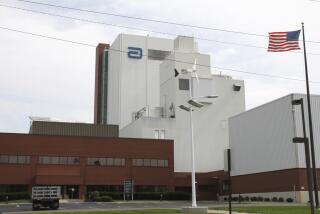Ben & Jerry Fortunes Improve as Production Returns Home : Profit: Opening a new plant in Vermont has cut production costs and turned the books around less than a year after the ice cream maker’s first-ever loss.
- Share via
WATERBURY, Vt. — Each carton of Cherry Garcia, Rainforest Crunch and Chocolate Chip Cookie Dough rolling off the line at Ben & Jerry’s new factory is a pint of profit that’s turning the ice cream maker around.
Less than a year after recurring problems in opening a new plant caused the company’s first-ever loss, the factory now is helping revitalize the company’s balance sheet.
Ben & Jerry’s third-quarter profit, announced earlier this month, rebounded 78% to $2.5 million over the same period in 1994. That was despite a dismal sales increase of 1% for the quarter and 4% for the first nine months of the year.
“The patient is stabilizing and recovering nicely,” said Jean-Michel Valette, an analyst with Hambrecht & Quist in San Francisco.
Chief Executive Robert Holland Jr. attributes the progress both to improvements at two existing plants in Vermont and to the long-awaited April opening of the new factory in St. Albans.
Dealing with the loss and straightening out problems in the St. Albans plant that repeatedly delayed its opening were the first crises that Holland had to resolve when he was hired late last winter.
Lewis Alton of L.H. Alton & Co. believes that Ben & Jerry’s is fundamentally a strong company that got into trouble only when the St. Albans plant would not operate as designed.
“These guys ran a portion of their business extremely well for a period of time,” Alton said, mentioning products such as Chocolate Chip Cookie Dough ice cream and low-fat frozen yogurt.
“What they did wrong is they made a decision to put in a new ice cream manufacturing facility with state-of-the-art technology that had not been proven.”
Ben & Jerry’s still is sensitive about the plant. It wrote off $6.8 million before taxes to ditch the plant’s state-of-the-art equipment and replace it with conventional machines.
Even now that the new factory is open, Ben & Jerry’s refuses to give tours, at least to the media.
Management has “kind of put a blanket over it until everything’s done,” said spokesman Rob Michalak. “There’s some details, some part of the back end of the system, being completed, plus they have some other minor things.”
But with the factory in full production, Ben & Jerry’s has been able to make all its ice cream in Vermont for the first time in six years. Previously, Dreyer’s Grand Ice Cream in Fort Wayne, Ind., made one-third of the ice cream.
The change cuts production costs, as well as allowing Ben & Jerry’s to promote its products as “Vermont’s Finest” without adding any footnotes about Midwestern production.
That’s important to a company that relies heavily on its use of the Vermont name as a marketing device. As well, it allows the company to fulfill its mission of providing decent jobs to the depressed Vermont communities that gave it its start.
Holland has been moving more slowly to resolve systemic management and marketing shortcomings that festered under the more relaxed leadership of company co-founders Ben Cohen and Jerry Greenfield.
He has hired a new chief financial officer and added managers experienced in such key areas as inventory control and manufacturing.
“We will need to make investments in people to make this happen and this process is well under way,” Holland said.
Beyond that lie larger questions about how to continue growing in a sector of the dessert food market that has flattened out.
“Long term, Ben & Jerry’s is a fantastic brand franchise that I think extends beyond ice cream,” Valette said. “It’s associated with flavor, quality, indulgence. Why couldn’t that be expanded to, say, a cookie? I think there’s a world of opportunity out there.”
More to Read
Inside the business of entertainment
The Wide Shot brings you news, analysis and insights on everything from streaming wars to production — and what it all means for the future.
You may occasionally receive promotional content from the Los Angeles Times.










